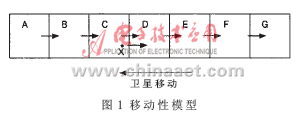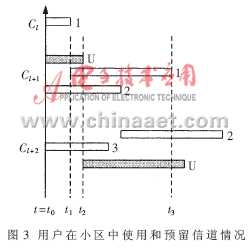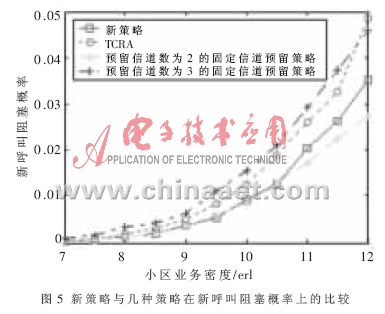A strategy of occupying reserved channels in a low-orbit constellation communication system based on TCRA
In low-orbit (LEO) constellation satellite communications, currently existing channel allocation strategies generally emphasize a lower probability of handover failure to ensure the quality of service of the call in progress. Channel reservation strategy is one of the effective methods to reduce the probability of call handover failure [1]. Among them, the time-based channel reservation algorithm (TCRA) [2] reserves a channel in advance for a handover call by a cell, which can achieve zero handover failure. However, this strategy leads to a higher probability of new call blocking, resulting in a reduction in channel resource utilization. Reference [3] proposes an over-reserved time channel reservation algorithm (TCRA-O), which assumes that there are S virtual channels on the basis of a fixed allocation of C channels per cell. This approach also improves channel utilization, but does not consider the user's location information, causing some unnecessary handover failures. In Reference [4], the number of reserved channels of the algorithm takes into account user location information and the duration of the call, but in a model where the duration of the call follows a negative exponential distribution, the strategy is not accurate enough.
This paper proposes a TCRA-based strategy for occupying reserved channels. Based on TCRA, it effectively uses the geographic location information of users. This strategy is based on the principle of little or no impact on the quality of service of the calling user, and it tries to accept new call requests with a small risk of handover failure, which improves the system's resource utilization.
1 Time-based channel reservation algorithm (TCRA)
1.1 Mobility model At present, a lot of mobility models suitable for the simulation and analysis of LEO constellation communication systems have been proposed [4-5]. This article uses the one-dimensional mobility model described in Figure 1 [4]. Among them, AG is a square cell connected to each other formed on the ground by a satellite multi-beam antenna. Assuming that these square cells are fixed, all users in the cell move in the opposite direction to the satellite at the same speed, and the speed is equal to the satellite sub-satellite speed. The model assumes that the user is equipped with a positioning system, and the user's position is determined when the call begins. For users who know the moving speed, direction and position, the next cell to be traversed and the handover time can be predicted.
1.2 TCRA-1
TCRA is an effective channel reservation strategy. It requires that the system only accept a new call request when the system can reserve a channel in advance for a newly arrived user. TCRA-1 is a TCRA strategy under the user's exact location information mode. The following is the specific implementation process of TCRA-1: 
Call setup phase: At the call setup time Tsetup, a user U requests a new call connection. The system sends a channel reservation request to the source cell C0 initiated by the user call and the first traversing cell C1, at the time intervals of two cells [Tsetup, Tsetup + T0 + σt] and [Tsetup + T0ï¼Ïƒt, Tsetup + T0 + T1 + σt] reserves a channel. Among them, T0 and T1 are the residence time of the user in the source cell and the traversing cell, respectively, and σt is an allowable error difference set in advance. If both requests can be satisfied, the call request is accepted.
Each switching stage: when a user on the call completes a switch from Ci to Ci + 1, the system allocates the channel reserved for it to Ci + 1, releases the channel in Ci, and sends a new request to Ci + 2 Within the time interval [THOi + T1-σt, THOi + 2T1 + σt], a channel is reserved for the user. Among them, THOi is the time when the user switches in Ci.
Call termination phase: When a user terminates a call in Ci, it will release the currently occupied channel and send a command to Ci + 1 to cancel the reserved channel.
This strategy can ensure that users do not fail to switch during the duration of their conversation. The principle has been explained in reference [2] and will not be described here.
2 A strategy of occupying reserved channels based on TCRA
2.1 Algorithm principle Although the TCRA strategy guarantees that the handover failure rate is zero, it causes a waste of system capacity. This problem is explained below.
As shown in Fig. 2, it is assumed that each cell has 2 available channels, and 3 connected users (Cl, Cl + 1, and Cl + 2) have 3 active users (User 1, User 2, and User 3) in the corresponding locations. . Figure 3 shows the user's channel usage and reservation in the corresponding time period in the corresponding cell. The abscissa represents time, and the ordinate represents the corresponding cell and corresponding channel. At time t0, user U at Cl + 1 sends a new call request to the system. Although there is an unused channel in cell Cl + 1 at this time, according to TCRA-1, the system has reserved a channel for user 1 at [t1, t3] , The normal channel reservation for user U cannot be made at [t0, t2], so the system rejects the new call request of user U. Analyze this situation. If any one of user 1, user 2, and user U ends their call before user 1 reaches cell Cl + 1, that is, between [t0, t1], even if the system accepts user U as user 1 The request to reserve a channel does not cause the system to fail. TCRA's reservation strategy failed to make full use of the system capacity, resulting in a waste of resources. By analogy, if the system channel capacity is increased to 20 or even higher, such a waste of resources will be more serious. 

The TCRA-based reserved channel strategy is based on the improvement of TCRA-1. The basic idea is as follows: At time t0, a new calling user sends a request to the system to use the channel of this cell. There is a reserved record, assuming that the system accepts this new call, based on the location information of the user currently talking, predict the worst case (that is, all users who use and reserve the channel of this cell have been on the call), causing the user to switch calls At the time t1, record Δτ = t1-t0. If Δτ is greater than a certain time threshold ΔT, it is considered that the user occupying or reserving the channel of this cell is more likely to end the call within the time interval [t0, t1]. At this time, as long as the system can reserve a channel for a new call within the corresponding time interval of the next cell, the user U's new call request is accepted. Otherwise, the new call request is rejected. Such a strategy increases the number of successful new call requests, thereby more effectively using the system's channel resources. The size of ΔT is determined by the choice of business model and the definition of service quality. The appropriate time threshold ΔT is derived below.
Assuming that the call duration satisfies the negative exponential distribution with mean Tm, the probability density p (t) of the call duration distribution is: 
The memoryless nature of the negative exponential distribution determines that for the ongoing user whose call duration follows this distribution, its call end time is not affected by the duration of the call. Suppose that the probability of the end of the call of the user who has been in the call for T1 after T1 + Δτ is Po, then:

Since the duration of the call between the call users is independent of each other, the probability Po (n) of n active users to continue to hold the call longer than Δτ is: 
Therefore, it can be considered that in a cell where all channels are used by users or the reserved channel capacity is C, a new call arrives at time T0. If the system can predict that the acceptance of this new call may cause a handover failure at time T0 + Δτ Then, adopting the reservation policy of occupation to allow this new call to be accessed will cause the probability of system switching failure to be Po (C + 1).
Reference [6] derives that in the one-dimensional mobility model composed of square cells, if the new call blocking probability Pn and the handover failure probability Ph are both 0, then the average number of handovers nk that each call needs to experience in the system is : 
Among them, Vsat is the moving speed of the satellite's sub-satellite point, and R is the length of the square cell.
Class of service (GoS) is an important indicator reflecting QoS, which is determined by the probability of new call blocking and the probability of handover failure [6]:

Among them, k> 1 is the balance factor between the new call and the handover call GoS, which is usually taken as 10 in some literatures. The lower the service level, the better the communication quality, indicating the better channel allocation strategy; the impact of the handover failure probability on the service level is k times that of the new call blocking probability.
In order to ensure that the improved strategy has better QoS, the GoS of the improved strategy is required to be lower, combined with the definition of GoS, we can get: 
Among them, Pn2 and Ph2 are the new call blocking probability and handover failure probability generated by the system after policy improvement; Pn1 and Ph1 are the new call blocking probability and handover failure probability generated by the original policy, respectively. In order to express the algorithm more clearly, this article introduces the corresponding call statistics into the calculation, equation (6) can be expressed as: 
Among them, Nnbi, Nni, Nhbi, and Nhi are the number of new call blocks, the number of new calls, the number of handover failures, and the handover in a period of time when the original strategy (i = 1) and the improved strategy (i = 2) are adopted. Quantity. Nn1 and Nn2 can be made equal, written as: 
The mobility model used in this paper satisfies the hypothesis requirements proposed by reference [6], which is approximately 0. According to reference [6], there are: 
From equations (7), (8), (9), we get: 
The denominator on the left side of the inequality indicates the number of new calls blocked by the new policy, that is, the increased number of new call accesses, and the numerator indicates the number of handover failures added by the new policy. There are also the use of the occupied channel strategy to allow the handover failure probability caused by new call access to be Po (C + 1), then: 
The time threshold on the right side of the inequality (12) is called the time threshold of the occupied channel, which is denoted by ΔT. Only when Δτ> ΔT is satisfied, can the improved strategy have better service quality.
2.2 Algorithm description When implementing the TCRA-based channel allocation strategy of occupying reserved channels, first calculate the occupying channel according to (12) according to the actual low-orbit constellation satellite mobility parameters, the number of cell channels and the relevant parameters of the business model Time threshold ΔT. The main algorithms executed in the life cycle of a call are as follows:
New call arrival phase: when a channel request is issued for a new call at T0, the system first executes the TCRA-1 strategy. If this strategy is met, the system allocates a suitable channel for the new call and implements reservations. If the new user stays in the cell time All channels have reserved records in the interval, then search for the latest reserved channel, assuming that the reservation start time is T1, then Δτ = T1-T0. If Δτ> ΔT and the reservation can be implemented in the next cell, the new call request is accepted; otherwise, the new call fails; if the system does not have an idle channel, new call access is also blocked.
Call switching phase: after switching, the user uses the channel reserved for the system in advance; the system predicts the moment of future switching and reserves a channel in the corresponding time interval in the future cell. If the above conditions cannot be met by the system, the call switching fails and the channel reserved for it is released. Regardless of whether the handover is successful, the call releases the current channel occupied by the cell.
Call termination phase: When the user ends the call, the channel occupied by the current cell is released, and the reservation request for the corresponding channel of the next cell is released.
3 Simulation results and analysis
3.1 Simulation model and basic assumptions The simulation in this article is based on the 7-cell network model, as shown in Figure 1. In the 7-cell model, the user terminal switches in the order from cell A to cell G, and the target cell for user switching in G is A. The 7-cell model can provide sufficient accuracy for the simulation, and the complexity is lower than the model using 98 cells [5].
The simulation assumes that the arrival time of new calls in the model follows Poisson distribution, and the location of new call users in the cell follows a uniform distribution; the duration of user calls follows a negative exponential distribution, and the average call duration is 180s; the cell length is 250km; The lower point speed is 27 000km / h; fixed channel allocation is adopted, and 20 channels are allocated to each cell on average; the error difference σt in TCRA-1 is 0; the GoS balance factor k is 10; and the simulation time is 24h.
3.2 Simulation results On the basis of fixed channel allocation, this paper uses TCRA, TCRA-based reserved channel strategy for occupying, and fixed channel reservation strategies with 2 and 3 reserved channels to simulate the communication process. Corresponding to different traffic, compare the three strategies of handover failure probability, new call blocking probability and GoS indicators. As shown in Figure 4, Figure 5, and Figure 6, comparing the several strategies, TCRA does not produce a handover failure. It is the advantage of this algorithm, but its new call blocking rate is higher; the switching failure rate of the fixed reservation of 2 channel strategies is the highest; the new call blocking rate of the fixed reservation of 3 channel strategies is the highest; the proposed new strategy produces a certain The handover fails, but the handover failure rate is only 7.7 × 10-4 even when the traffic is 12 Ireland. In terms of the blocking probability of new calls, it is significantly better than the reservation strategy and TCRA strategy of fixed reservation of 3 channels. Corresponding to different traffic, the strategy can almost reduce the blocking probability of new calls by 20% compared with TCRA. Among several strategies, the new strategy proposed in this paper has the lowest GoS. In summary, compared with TCRA and two fixed channel reservation strategies, the new strategies have better QoS and can better utilize the channel resources of the system. 


In order to further improve the channel utilization of the low-orbit constellation communication system, this paper proposes a channel allocation strategy based on TCRA to occupy reserved channels. This strategy effectively utilizes the memoryless nature of the negative exponential distribution model of call duration, takes into account the requirements of call service quality, and greatly improves the channel utilization rate when a small number of handover failures are allowed. Through simulation, the strategy is compared with the TCRA algorithm and the fixed channel reservation algorithm in both handover and new call performance. Simulation results show that the strategy is a channel allocation strategy for the low-orbit constellation communication system that not only guarantees the QoS of the call, but also can make full use of the channel resources.
| About Copper Accessories |
Copper Accessories includes Plastic Spool, insulating paint and cable wire, plastic has colorful choose for you .insulating paint has two kinds of packages (200 kg and 1000 kg). cable wire is very flexible .House wiring cables and feeder cables.

Copper Accessories
Copper Accessories,Low Oxygen Copper Rod,Upcast Process Copper Rod,Copper Round Bar
HENAN HUAYANG ELECTRICAL TECHNOLOGY GROUP CO.,LTD , https://www.huaonwire.com